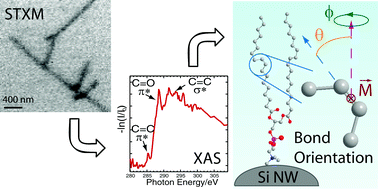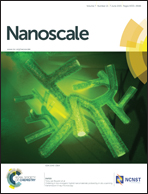Ordering in bio-inorganic hybrid nanomaterials probed by in situ scanning transmission X-ray microscopy†
Abstract
Phospholipid bilayer coated Si nanowires are one-dimensional (1D) composites that provide versatile bio-nanoelectronic functionality via incorporation of a wide variety of biomolecules into the phospholipid matrix. The physiochemical behaviour of the phospholipid bilayer is strongly dependent on its structure and, as a consequence, substantial modelling and experimental efforts have been directed at the structural characterization of supported bilayers and unsupported phospholipid vesicles; nonetheless, the experimental studies conducted to date have exclusively involved volume-averaged techniques, which do not allow for the assignment of spatially resolved structural variations that could critically impact the performance of the 1D phospholipid-Si NW composites. In this manuscript, we use scanning transmission X-ray microscopy (STXM) to probe bond orientation and bilayer thickness as a function of position with a spatial resolution of ∼30 nm for Δ9-cis 1,2-dioleoyl-sn-glycero-3-phosphocholine layers prepared Si NWs. When coupled with small angle X-ray scattering measurements, the STXM data reveal structural motifs of the Si NWs that give rise to multi-bilayer formation and enable assignment of the orientation of specific bonds known to affect the order and rigidity of phospholipid bilayers.



 Please wait while we load your content...
Please wait while we load your content...